F-86 Sabres XD707 and XD730
‹ Return to Air Crash Sites
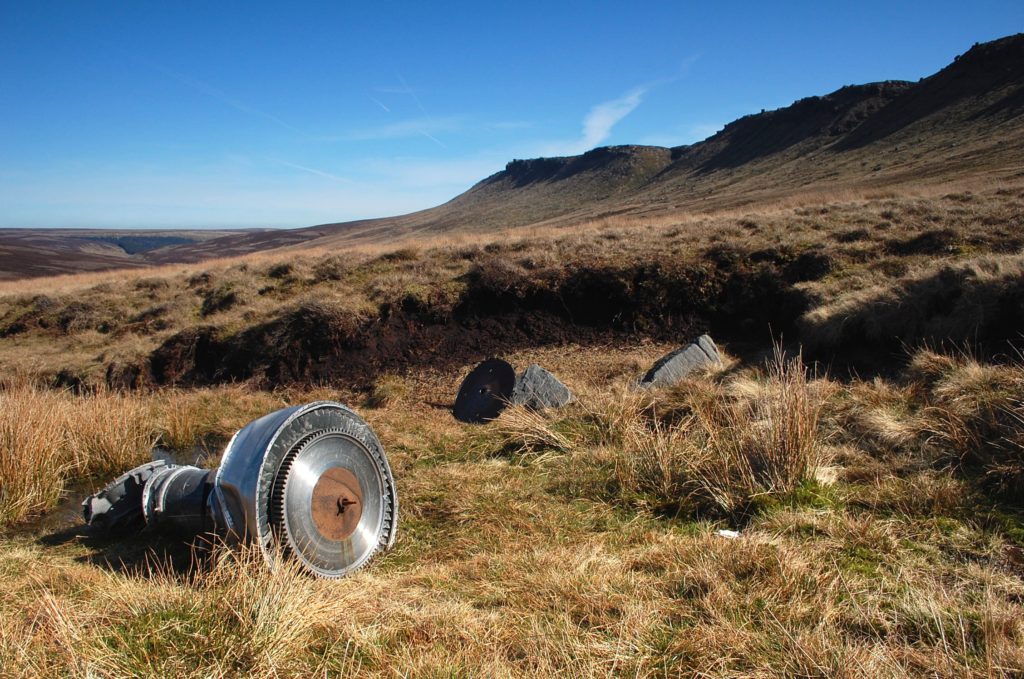
F-86 Sabres XD707 and XD730, Kinder Scout
Page updated October 2023, please scroll down for new photos and grid refs.
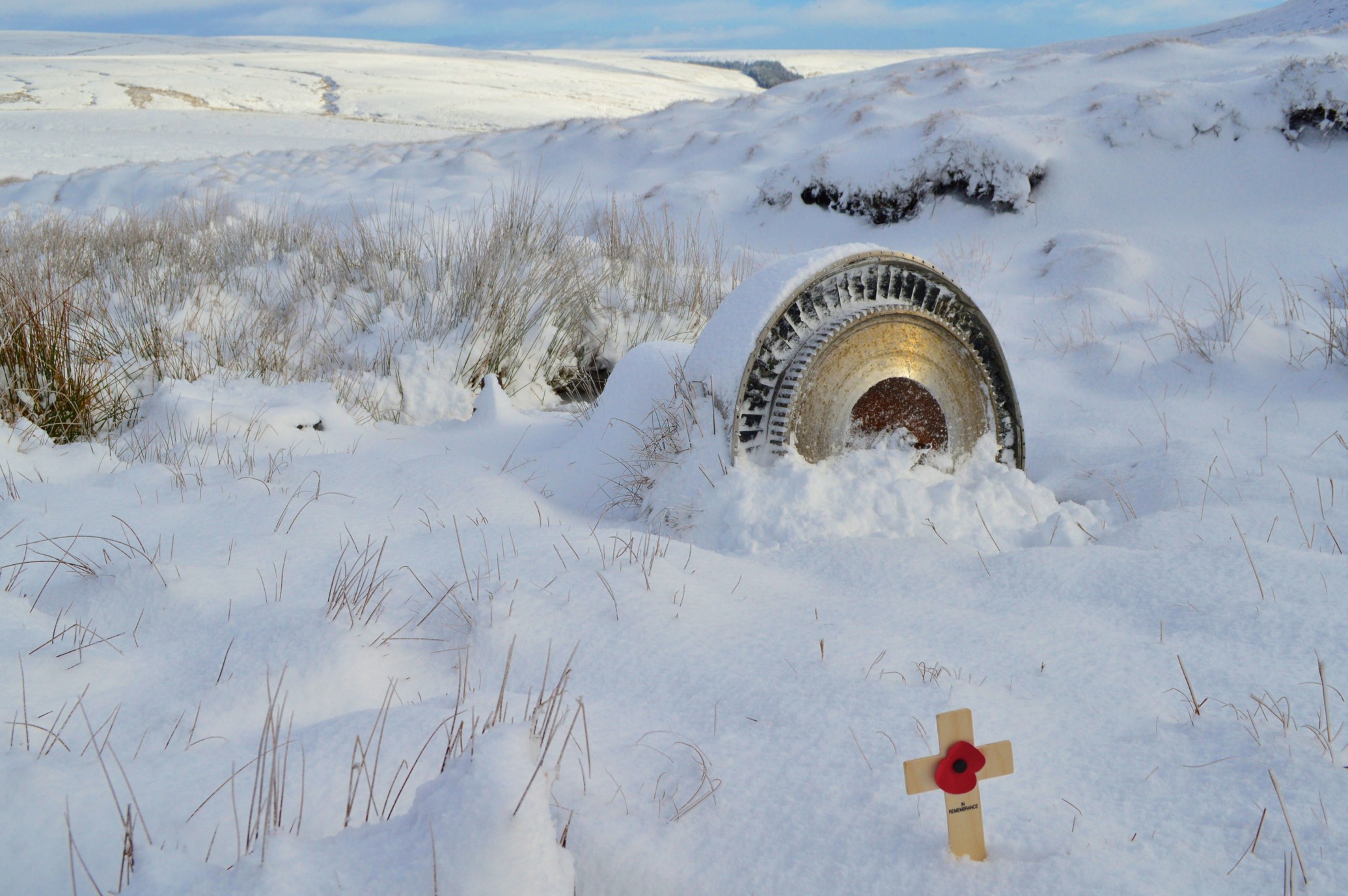
22 July 1954. Four RAF Sabre jets from No 66 Squadron had taken part in “Exercise Dividend” practicing air defences against a simulated attack on Britain by Soviet nuclear bombers. It was a huge undertaking, the largest since the war and a total of 6 aircraft across the country were lost that day, two of them here on Kinder Scout in the Derbyshire Peak District.
Upon completion of the exercise the jet fighters were heading back to base at RAF Linton-on-Ouse. Split into pairs, Flying Officer James Desmond Horne (XD707) led Flight Lieutenant Alan Green (XD730) down through dense cloud at around 6pm. Although advised by the leader of the other pair of jets not to descend below 3,800ft, F/O Horne’s radio had not been working very well and so may have misheard the advice.
The Sabres were seen tearing 1000ft above the Kinder Reservoir having dropped through the clouds, apparently unaware of the steeply rising plateau directly in front of them. It appears F/O Horne saw the slope at the last instant and pulled up sharp.
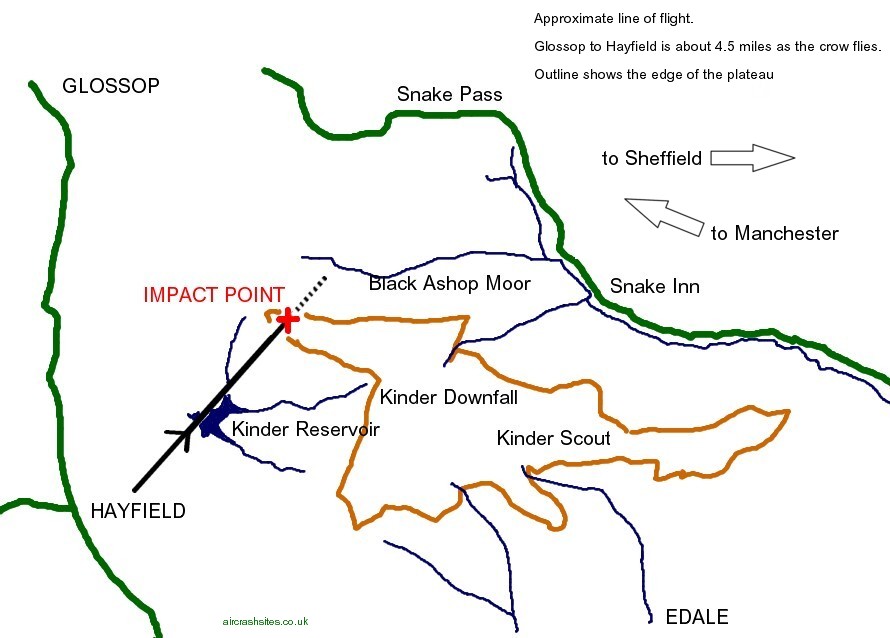
Exactly what happened is not known but the jets collided and tumbled out of control, down from the plateau edge and onto the moor below. No-one knows for sure what happened. A body and the wrecked aircraft were discovered 3 days later by a hill walker.
The keeper at Kinder Reservoir, Mr Vernon Bennett, had seen two aircraft above him. The crash occurred on Thursday 22 July 1954 but bad weather had hampered search efforts. Collier cites the official record saying that two climbers had met a rambler who said he had seen the aircraft collide. Amid the noise he saw the aircraft touch, then “one went into a flat spin while the other began to roll. The whole scenario had been quickly swallowed up in the cloud.”
The following Sunday, Mr Atkin was walking from Ashop Head along The Edge, to Fairbrook Naze. He saw something white ahead of him, which turned out to be a partially deployed parachute with the body of the pilot close by and he descended to the Snake Inn and dialled 999 to report the accident. The weather report for that day was heavy rain and cloud, with strong winds.

I once had the opportunity to speak with a former USAF Colonel who used to fly F-86 Sabres, he said generally they were about 10 feet apart when flying in formation – and that at a cruising speed of 500 mph.
You can follow the trail from the point of impact on the plateau down to Black Ashop Moor, there are fragments all the way down over a distance of about 1km.
SK 06926 89664 – Impact site
SK 07268 90236 – Wings, engine, landing gear.
SK 07300 90100 – Debris, electrical components
SK 07548 90390 – Engine in boggy area
See further below, update October 2023 for more grid references.
Below; The impact site.
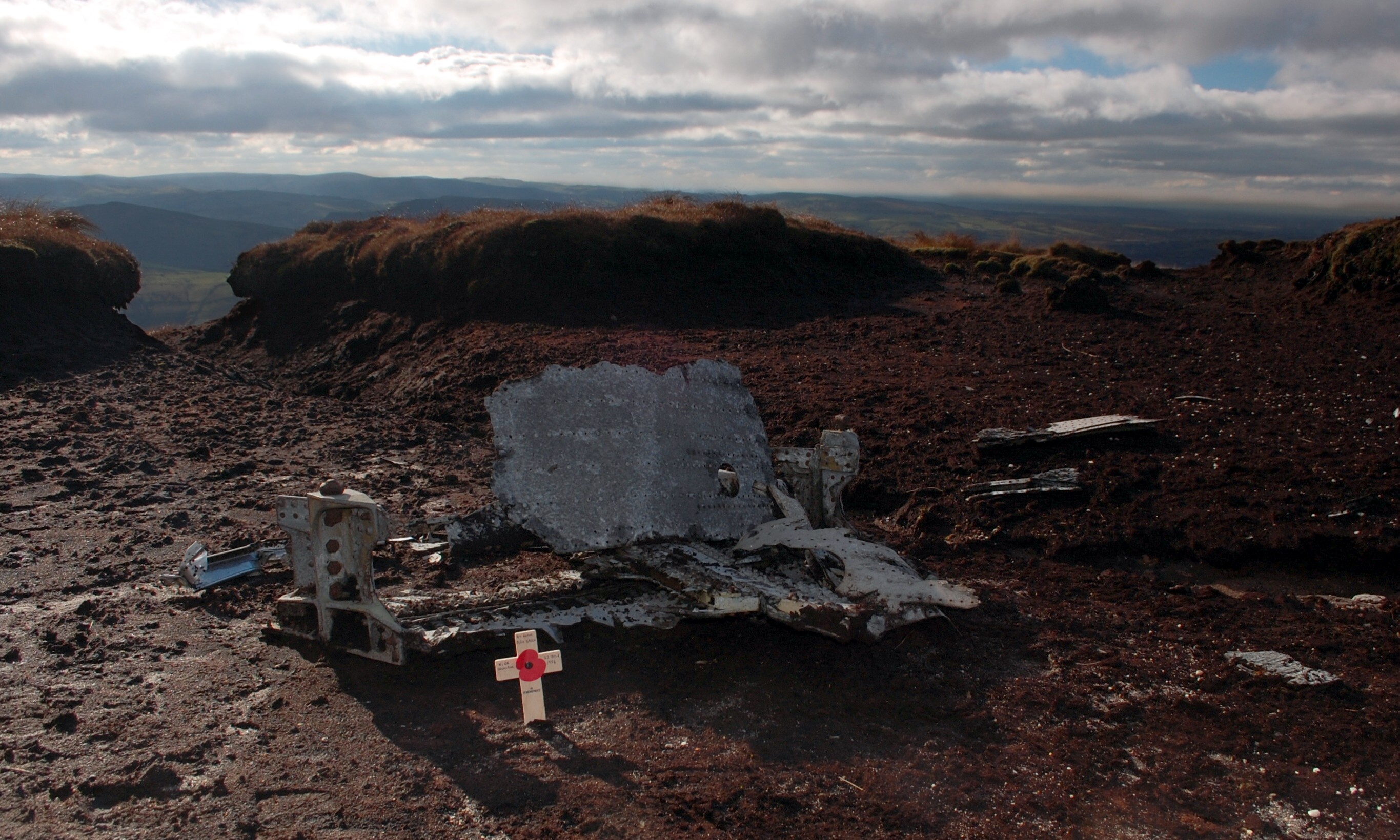
Below;
Looking back along the line the aircraft tumbled onto Black Ashop Moor from the Kinder Scout plateau. The two Sabres crashed on the higher ground right above the corner having pulled up sharply from the other side to clear it. The wreckage is spread over a good kilometre from the impact site.

Tailplane section

Below; Propped up fuselage sections

Below;
Looking towards the north-eastern corner of Kinder Scout.


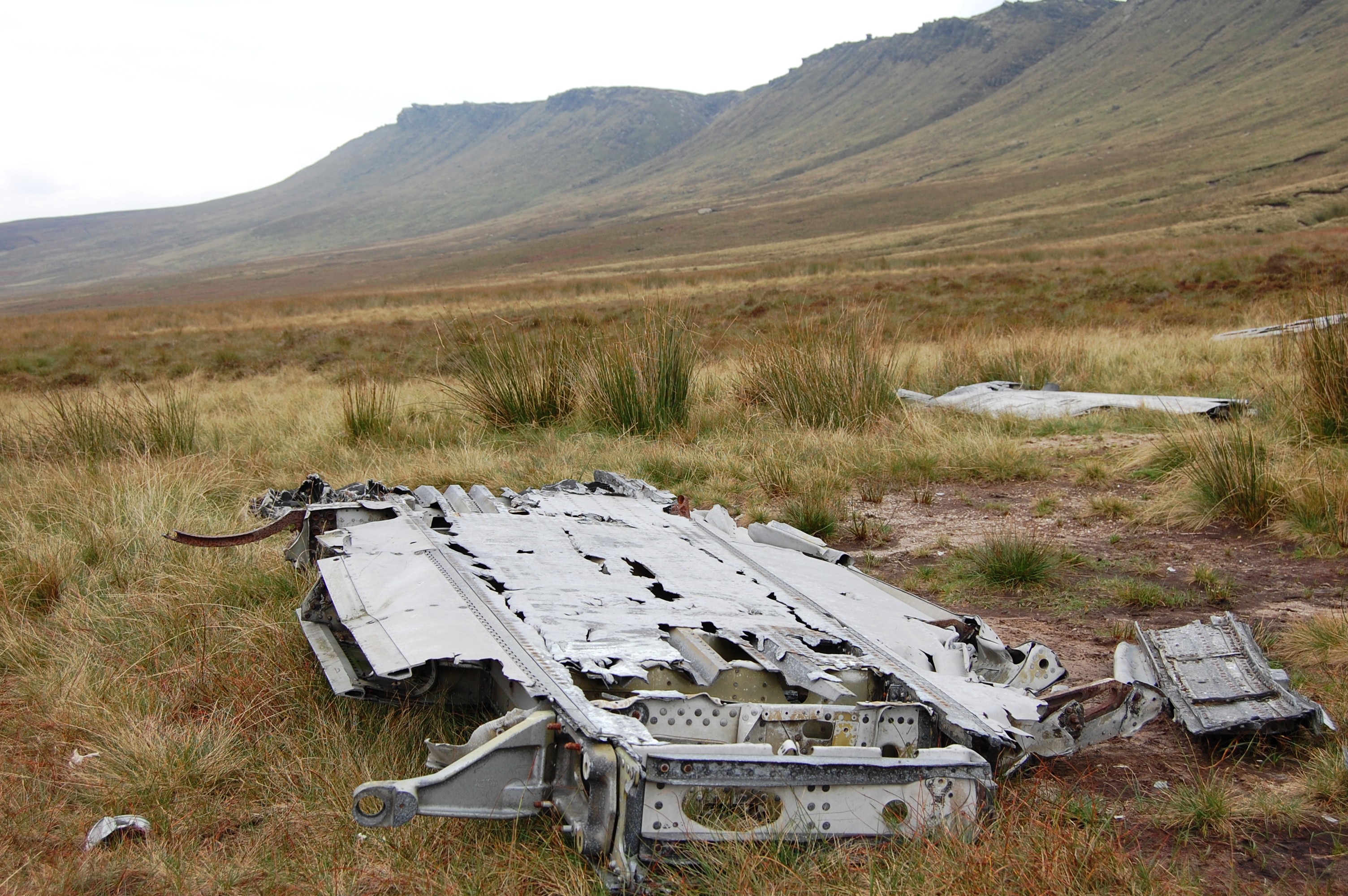
XD 727, another F-86 Sabre from No 66 Squadron.
© Crown copyright 2010

No 66 Squadron lost two pilots flying in formation over the area a few years earlier, when
Gloster Meteors WA791 and VZ518 crashed on Black Hill in 1951.
Below;
For a long time the engine in the lead photo was upended in the bog.
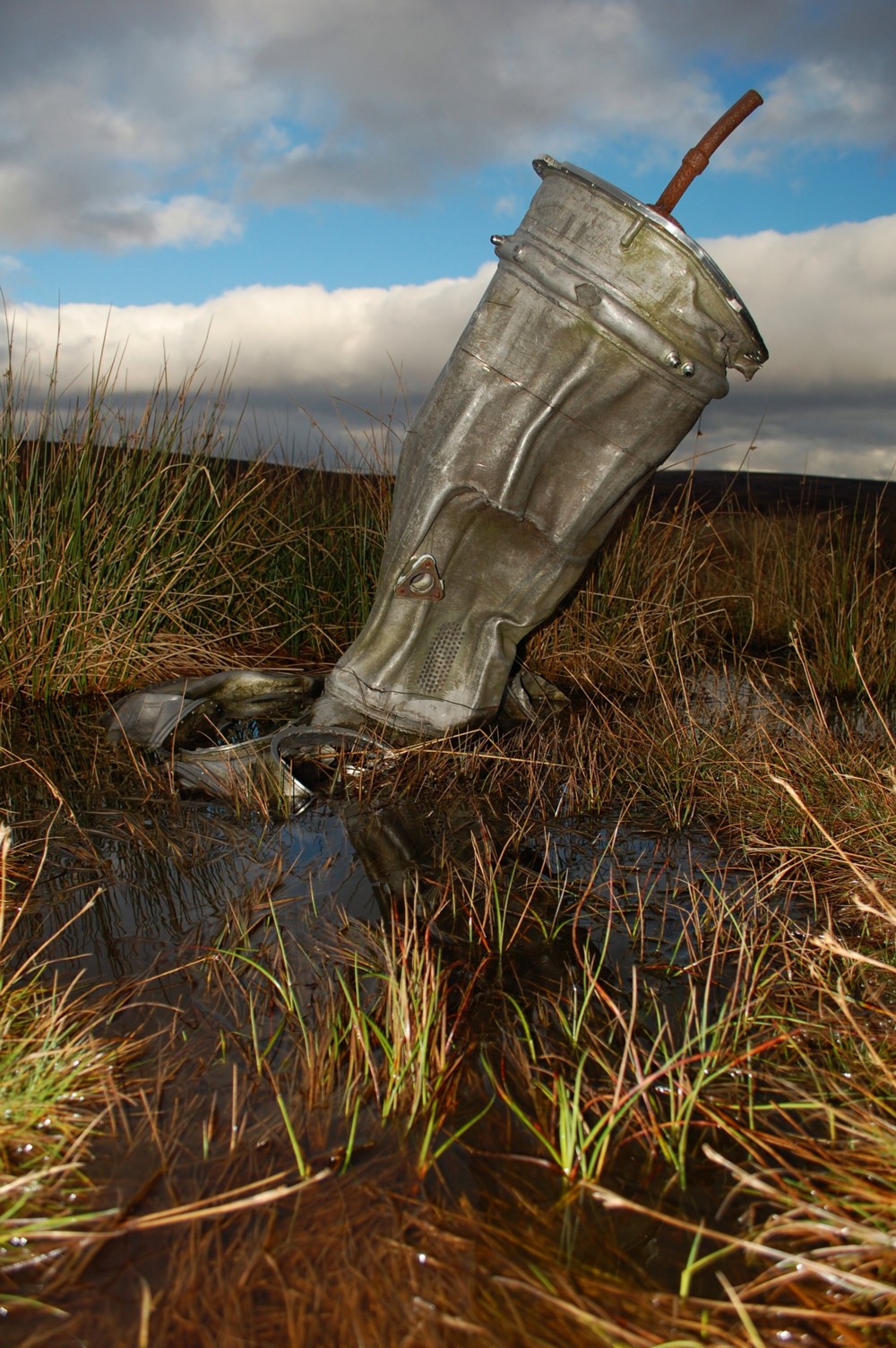
UPDATE 08 OCTOBER 2023
Yesterday I made a sunrise visit to the crash site, walking in the dark along the Pennine Way hoping to photograph the debris in the early morning light. However, as is often the case here, the clear skies and 21 degrees forecast did not happen. I managed a couple of dull snaps before a shroud of cloud covered the whole of Kinder Scout. So instead, I climbed up the steep escarpment along the line the aircraft fell, to note the other pools of debris and to provide some more grid references.
Dawn at the site.

This bit of debris was at grid reference SK 07138 89955. Circled you can just make out the debris at the terminal site.
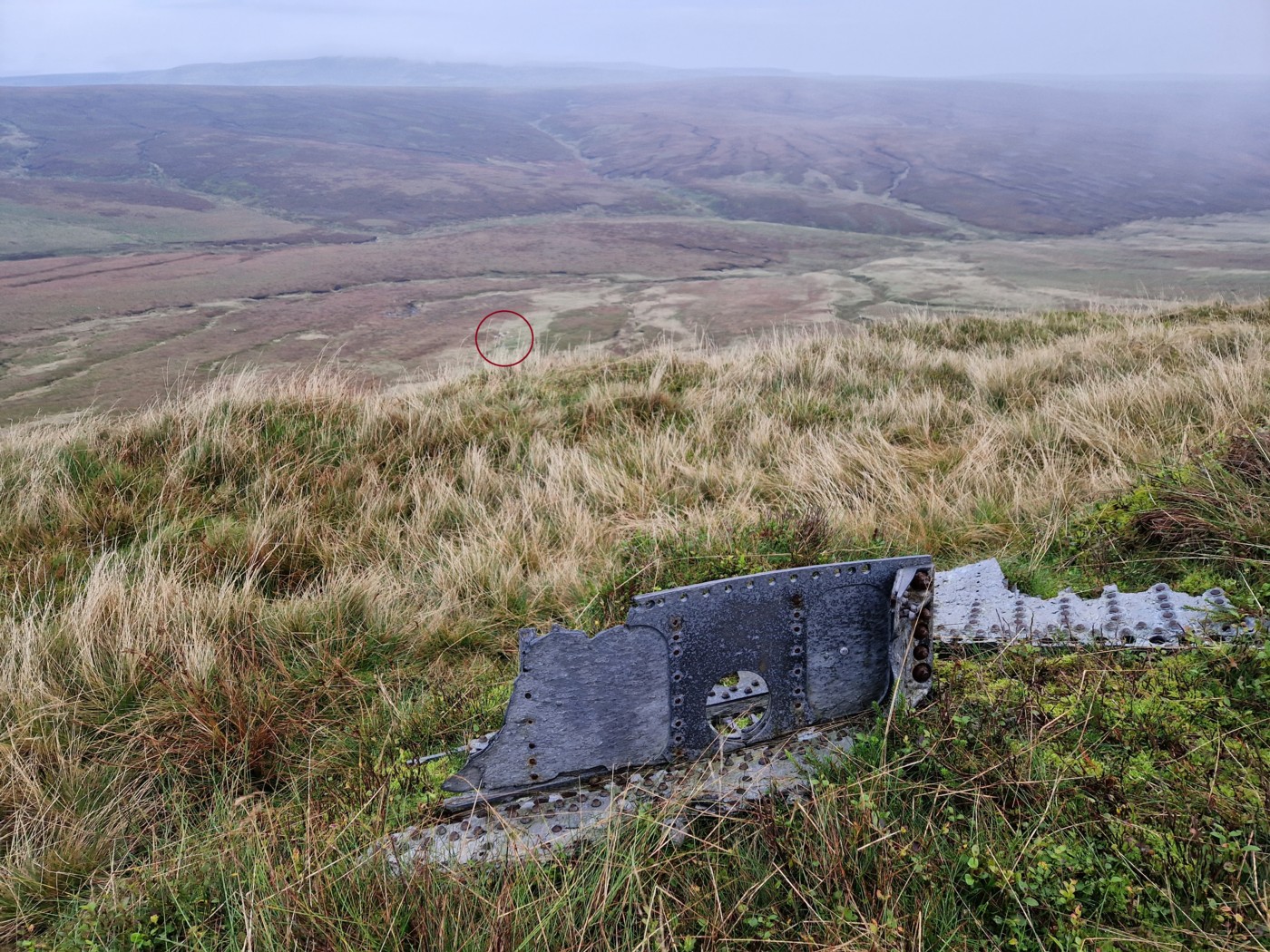
This debris pool is at SK 07014 89796

And this one at SK 06980 89720
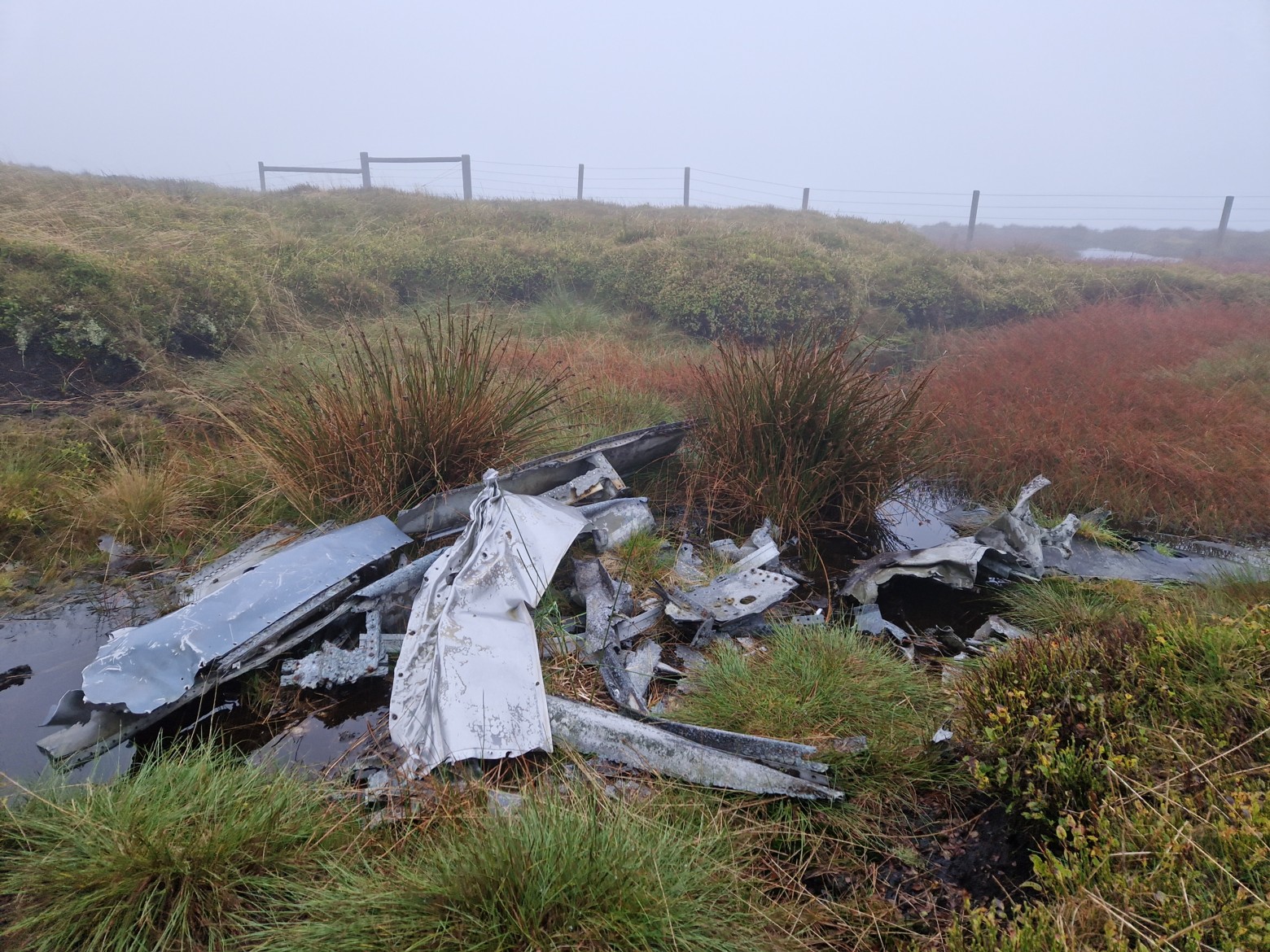
Substantial remains at grid reference SK 06954 89704

Below: at the impact site there are fragments of metal and rubber all around. This piece of debris is the first bit of debris on the moor. Or the last, depending on how you approach the site. It is at grid reference SK 06954 89704. The climb up from Black Ashop Moor was a slog, there are easier ways up to the plateau. If wanting to follow the trail, I’d recommend starting here at the impact point and descending to the terminal sites.
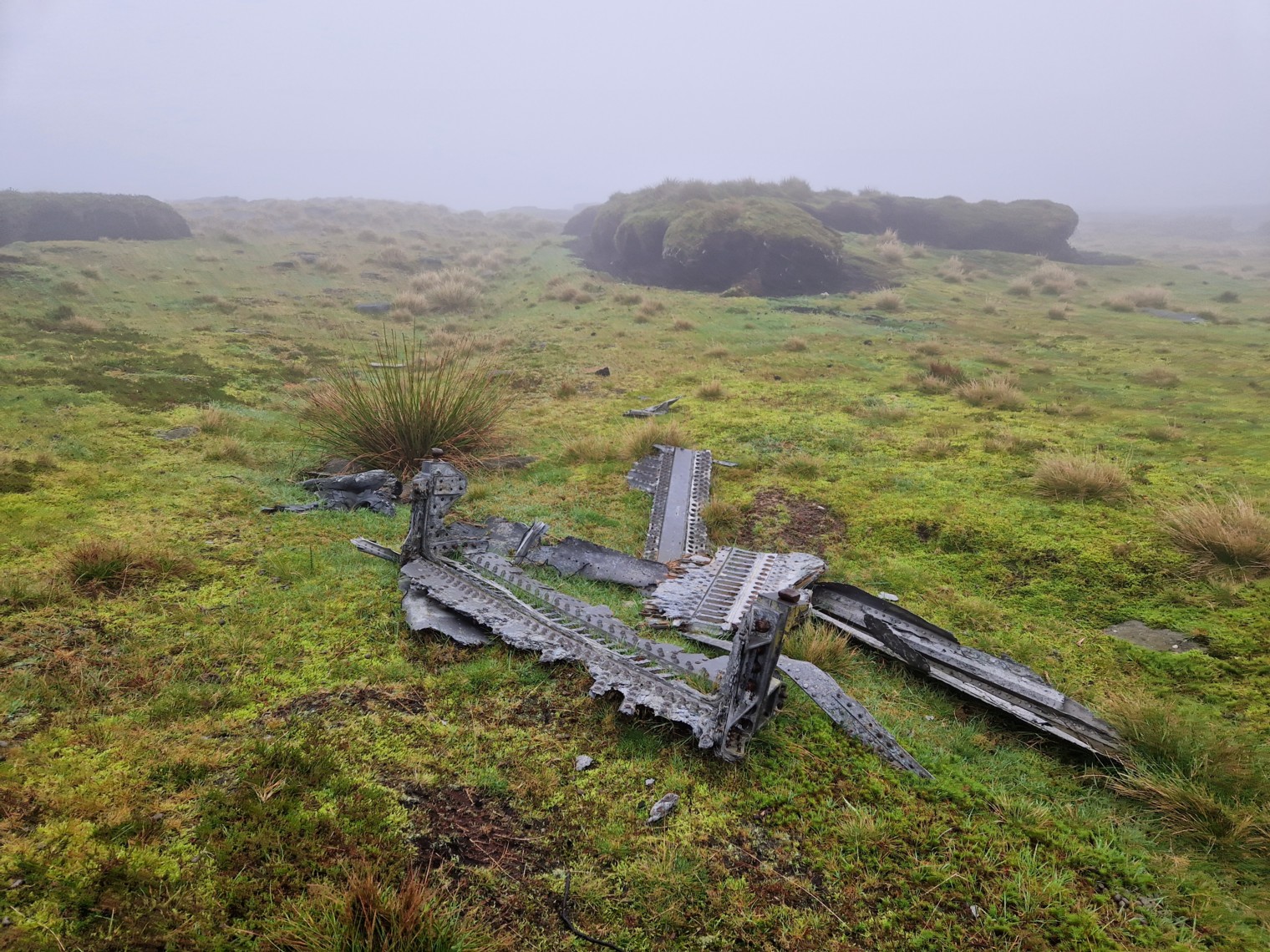
This view is taken from Ashop Head and the top of William Clough where the paths cross. The conditions in which Sabres XD707 and XD730 crashed were probably similar. They approached from the right having been seen above Kinder Reservoir, F/O Horne pulled up the moment he saw the hillside in front of him and cleared the moor, but the aircraft collided nonetheless.
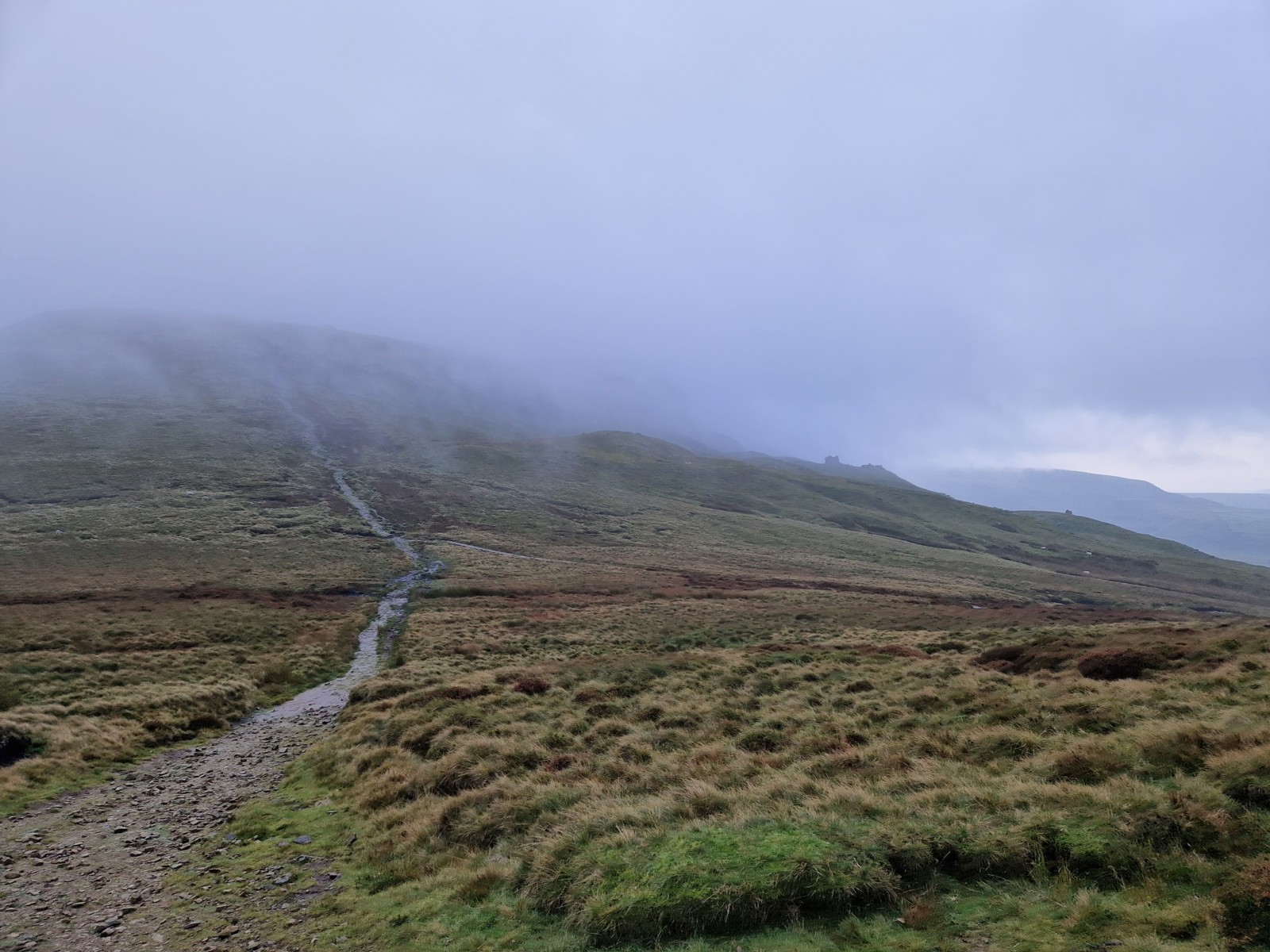
43 comments on “F-86 Sabres XD707 and XD730”
1 Pings/Trackbacks for "F-86 Sabres XD707 and XD730"
-
[…] of two planes that crashed in July 1954,” explains Don. “They’re a pair of F86 Sabre fighters belonging to the RAF’s 66 Squadron who were on training manoeuvres and returning to base at […]
Leave a Reply to Guy Fothergill. Cancel reply
Image Information
-
Full Size: 2256×1496px
Aperture: f/8
Focal Length: 18mm
ISO: 200
Shutter: 1/320 sec
Camera: NIKON D40

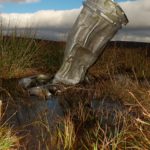

More great stuff from your camera lens Ian. G-SABR in the Aircraft Restoration Company’s collection at Duxford is probably my favourite classic jet flying in the UK. Last year it was for sale for £600k, but it doesn’t look like anyone had a wallet big enough to cover the fuel bills…
Remember when me n my mates used to don our ruck sacks and walking boots back in the sixties and go up kinder from the hayfield side,we would be about thirteen,remember coming across a downed aircraft up on the platou with all the shiny aluminium,long long ago.
That could be the downed light aircraft that crashed onto Kinder behind Kinder Gates around 1965. It was remarkably intact. Nothing remains now it was all taken away.
use to be my faviorite plane when i was a youg un, great story ian and photo
The shine on that metal makes it look like it was just put there last week.
Amazing just how much remains.!
I was also thinking it is surprising how much is left of the wreckage Ian!! An amazing story and brilliant series of photos !!!:-)
Great stuff Ian, Thanks for taking the time to tell this story properly and thanks again for showing me around the sites.
Good shot of the 66Sqn Sabre and Mike – that Sabre was awesome at Duxford autumn show last year!
Gday, Thats a 92 sqn Sabre. 66 squadron had a solid white bar surrounded in blue either side of the roundel. They were neighbouring squadrons at Linton-on-Ouse. My Father flew for 66sqn 1953-1956.
XD 707 had my Fathers name on it but was flying another sabre that day in excecise Dividend.”J” is listed in his log book for that day.
The shiny metal is gleaming in the sun.
Another of those wrecks I must have gone past so many times.
Brilliant Ian. How long does it take to walk there from the road?
Epic find and info Ian….another of my wonderful Flickr contacts used to fly F-86 Sabres!
I will ping him a copy as I know he will be interested 🙂
Brilliant work here again mate.
Superb work and a cracking set of photos, going out in the hills myself these next few days.
great series of images, each composed wonderfully. fantastic presentation here, really appreciate the map detail and the descriptions regarding which way the pic faces. truly helps to get a picture of the situation.
tragic day for the pilots – a loss of 6!! i wonder if they were all lost in pairs, considering the formation flying. formatting in cloud – dense cloud, where trying to stay on your lead, well incredibly dangerous really. can’t say i’d ever want to practise it ..
[http://www.flickr.com/photos/angwickham]
Many thanks indeed, glad the map helped.
I did take a look into the other losses a while back Ang. If I recall there were two Meteors which collided near RAF Leuchars near Dundee – I think they both ejected, though may be wrong. Then there was another Sabre in Yorkshire (?) and a Canberra bomber… which may have been in Norfolk? But I could be miles out. Need to research them. Bugger, that’ll bother me now till I find out where they are and what happened to the crews!
Just been reading about this in ‘Sabre, The Canadair Sabre in RAF service’ by Duncan Curtis.
http://www.amazon.co.uk/Sabre-The-Canadair-RAF-Service/dp/075094...
I got this book as I love Sabres and it mentions my Dad quite a bit. He was flying Sabres during that period in the 50’s. Dividend is mentioned quite a bit. I’ll look into it.
[http://www.flickr.com/photos/testchamber]
Cheers Dave, any info / corrections welcomed.
Just had a look at that book. My trigger finger was hovering over Buy Now With One Click…. Gets good reviews. Your Dad gets mentioned, you say?
Just reading about 66squ now….It mentions 3 lost on first day of phase2 on the 22nd July. Fg Off Glyn Owen fortunately ejected from XD758/L when it’s fire warning light illuminated north-east of Helmsley.
My Dad was in 130 Punjab Squadron.
Unbelievable at the amount of loss on that day… Sometimes, some of us are in awe as to how something like this can happen… but I think back to when I was a young and fearless teenager behind the wheel of a sports car. These pilots were like me in mindset.
Tragedies nevertheless, as would be a young person behind a steering wheel with pedal to the metal.
RIP.
Thanks Ian. This is an interesting and well compiled account of a tragedy which must have affected not just the families and squadron, but the whole RAF.
I’m amazed at the good condition of the wreckage especially that turbine stage.
[http://www.flickr.com/photos/maycontaintracesofnuts] oops sorry! didn’t mean to create you more ‘work’ with my musings.
Great work as always. Hard to believe those things are still just lying there, a living sculpture dedicated to the memory of the fallen. Something very serene but also alien about the effect.
As you have said before, this area seems to have a high attrition rate from what I can see. There looks like some large lumps left
Hi Ian Pleasure to meet you guys last week.Thanks for making the effort to come along.Did you get an ice cream?
10 feet eh? Brave guys. Great research here as always.
[http://www.flickr.com/photos/21138488@N08]
Thanks David. Think I will get a copy of that book. Be interesting to read about your Dad.
[http://www.flickr.com/photos/29551624@N03]
No problem Ang, it’s something I like doing!
Re; Other aircraft lost on Exercise Dividend, 22/07/54
As Dave points out Sabre XD758 crashed on Skiplam Moor, near Helmsley. The pilot, F/O Glyn Owen had ejected safely and parachuted down. He was married two days later but tragically he was killed on 28 August 1964 in an English Electric Lightning at RAF Leuchars.
Two Gloster Meteors collided north of RAF Leuchars while simulating an attack on a Seahawk; Flying Officer F R Bennet safely ejected from Meteor WL114 but the pilot of Meteor WE897, F/O Hugh Johnstone Gourley was killed in the collision.
Also that day, the 3 crew members of Canberra WJ720 were killed when their bomber crashed at North Elmham in Norfolk.
[http://www.flickr.com/photos/stopherjones]
Cheers Chris, the remains do sometimes look like that. But I am glad the stuff is still there. It won’t always be.
[http://www.flickr.com/photos/andyholmfirth]
Hi Andy, yes lovely to meet you. We did indeed get an ice cream from Longleys (?). Good call!
[http://www.flickr.com/photos/amybigkiss]
You’re not kidding Amy. Thanks. Hope all’s well.
[http://www.flickr.com/photos/pasujoba44]
I had seen from other photos it had been pulled out. Worth another visit to be honest Paul. [http://www.flickr.com/photos/cachelog]
You got that right Bryan, lots of plane crahes on Kinder Scout as you have noticed.
[http://www.flickr.com/photos/maycontaintracesofnuts] kind of stunning in a morbid way if you know what i mean .. i read of training accidents from during WWII and you kind of ‘expect’ it back then when they were still getting to grips with aircraft with alot of power, night flying and flying in sht wx with minimal navaids … but then, i guess the 50’s was all about getting used to jets and even more speed and design issues. crazy way to learn, through accidents but i guess that is one of the fascinating things about aviation. a group of pilots together discussing accidents is like a group of scientists pulling something apart and analysing the … stuffing out of it, all the while being wierdly enthused in trying to work it out.
well composed frame, good work Ian
[http://www.flickr.com/photos/tomitheos] [http://www.flickr.com/photos/angwickham]
Cheers both.
Yeah, Ang, a lot of crashes continued to happen into the 1950’s and beyond, though the frequency dropped off sharply at the end of the decade, presumably due to better altimeters. But as you say, they were learning. Our aviation safety today is borne of the lessons learned back then. Though Airbuses do scare the crap out of me.
wonderful shot!
Wow, amazing. No matter how mundane the flight,,
you’re always within a millisecond of instant death
when you’re going 500mph in an aluminum cylinder.
As always both very interesting and beautiful.
Amazing story. I was up near the crash site yesterday and didn’t know about it. The map explains what happened really well. Thanks for sharing.
Gday. My father used to fly for 66 Sqn and according to him one of the planes had his name on it though another pilot was flying it. Flt lt Ira Fothergill. Have found a few of his former planes online, from venoms and vixens to C-47s. good health
Thanks Guy. Interesting detail about you dad’s name being on one of the aircraft. 66 squadron lost two Meteors and two pilots on Black Hill just to the north of this place in 1951 but the year before Sgt Joe Harrington successfully baled out of a 66 Sqn Meteor and earlier this year left a comment on my photo of the wreck site. These three wreck sites are all within a few miles of each other.
https://aircrashsites.co.uk/air-crash-sites-5/gloster-meteor-ra487-hagg-side-peak-district/
https://aircrashsites.co.uk/air-crash-sites-5/tail-section-of-a-crashed-gloster-meteor-jet-in-the-peak-district/
Thanks for all the info, we visited the impact area this weekend. I can’t believe how shiny it all was. Was the rubber from the fuel tanks?
Thanks David, I don’t know about the rubber. Aside from the stuff from the tyres it could be from the fuel tanks, as you say. I never noticed it last time I was up there!
I learned something today. I was part of that exercise, flying a Sabre of 20 Sqn as part of the attacking force. I never heard about there being an accident in Britain as a result of that.
The family of Flying Officer Horne placed a memorial plaque at the site. See https://www.iwm.org.uk/memorials/item/memorial/63276
He and Flight Lieutenant Green are both buried at All Saints churchyard, Newton-on-Ouse.
Another memorial to the pair is at the crash site placed there by 1890 Det Flt, Air Training Cadets. Unfortunately imperial War Museums’ War Memorial Register doesn’t yet have a picture. (See https://www.iwm.org.uk/memorials/item/memorial/19158)
Thanks again Richard, appreciate your additional info.
Ian